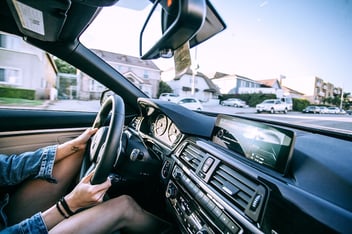SWIR Use in Traffic Surveillance Systems
Traffic surveillance systems implementing SWIR technology into their platforms have measured benefits in their efficiency. The use of SWIR image sensors grants the cameras the ability to quantify passengers, verify license plates especially during high-speed chases or toll road entrances/exits, and monitoring traffic conditions in any light condition. The advantages of using SWIR image sensors are that they are not only able to see through adverse weather conditions, but the images provided are not affected by light reflected from windshields.
Areas affected by adverse weather conditions, for example, San Francisco who is prone to extremely foggy conditions (as seen in the image below) pose problems for accurate traffic data. There is nothing worse than using GPS to monitor traffic or planning a trip based on the ETA provided to then be stuck in traffic that was not initially a part of the drive overview. With SWIR’s ability to see through dense fog or other types of weather conditions, satellites or other traffic cameras can provide GPS or traffic reports with accurate information on traffic conditions.

Image courtesy of NASA
In the use-case of law enforcement, SWIR can help officers to navigate in high-speed chases in adverse conditions. Traffic helicopters monitoring the scene can easily identify license plates when following a fleeing vehicle. The ability to see through the car’s windshield will also assist officers in identifying occupants including potential hostages. This added benefit will help guarantee the safety of surrounding vehicles, pedestrians, as well as occupants in the vehicle.
Issues facing toll roads is that the cameras used at the entrances or exits are often impeded by ambient light, glares, and weather conditions. This poses an issue for toll roads such as misidentifying plates or VINs and incorrectly billing vehicle owners. Using SWIR would help mitigate the issues that toll cameras face, with its ability to capture smaller light photons and decreased scattering the camera would not be affected by the sun’s reflection off the windshield or ambient light blowing out the image so that the camera system can properly identify the car’s information and driver. As well as seeing through organic matter, with smudges from dirt and grime lining plates a SWIR camera could properly identify the plate’s characters.
SeeDevice’s QPD sensor addresses all issues facing traffic monitoring systems including image quality in adverse weather and low-light conditions, blow-out from ambient light, sun reflectance in windshields, and plate identification. The QPD’s wide dynamic range and high sensitivity grants it the ability to use edge detection to accurately identify license plates in any condition and identify passengers through the car’s windshield. The implementation of the QPD sensor is beneficial for enforcement of traffic laws but also preventing accidents caused by incorrectly reported traffic jams and objects/animals in the road that visible cameras were not able to identify.



